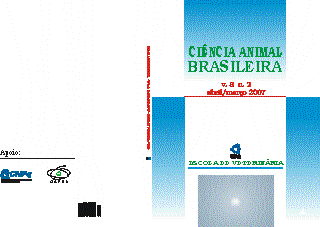APPARENT DIGESTIBILITY OF DIETS CONTAINING DIFFERENT PROPORTIONS OF TOMATO BY-PRODUCT
Keywords:
Resíduos industriais, Polpa de tomateAbstract
Sixteen lambs fed with 0%, 15%, 30% or 45% of tomato by product (TBP) in the diet were used in order to evaluate the intake (I) and apparent digestibility (AD) of dry matter (DM), organic matter (OM), crude protein (CP), neutral detergent fiber (NDF) and acid detergent fi-ber (ADF) in a randomized design. There were no diffe-rences in DM-I related to live weight (3,6%) and metabo-lic weight (91,7g/kg0,75) among the treatments. The 30% TBP diet showed higher OM-AD. It was found a linear effect for ADF-I and a quadratic response for NDF-I. The regression analysis revealed a negative effect of TBP in a CP-AD. For the others parameters there were no differen-ces among treatments. It was concluded that the TBP has good AD of all analyzed fractions and that proportions up to 45% TBP in lamb’s diet do not reduce the intake, howe-ver higher digestibility was found with 30% of inclusion.
KEY-WORDS: Apparent digestibility, intake, tomato by-product.
Downloads
Downloads
Published
How to Cite
Issue
Section
License
Copyright (c) 2007 Brazilian Animal Science/ Ciência Animal Brasileira

This work is licensed under a Creative Commons Attribution 4.0 International License.
Authors who publish with this journal agree to the following terms:
- Authors retain copyright and grant the journal right of first publication with the work simultaneously licensed under a Creative Commons Attribution License that allows others to share the work with an acknowledgement of the work's authorship and initial publication in this journal.
- Authors are able to enter into separate, additional contractual arrangements for the non-exclusive distribution of the journal's published version of the work (e.g., post it to an institutional repository or publish it in a book), with an acknowledgement of its initial publication in this journal.
- Authors are permitted and encouraged to post their work online (e.g. in institutional repositories or on their website) prior to and during the submission process, as it can lead to productive exchanges, as well as earlier and greater citation of published work (See The Effect of Open Access).




























